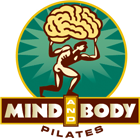I started going to Crossfit (see the link on this page) at the recommendation of a client. Crossfit has a point of view different than any other gym/circuit style workout out there. For one thing, it kicks my ass in 15-20 minutes and I think I am in relatively good shape. It also has assessment tools for measuring one’s progress. There are 4 levels and 20 or so exercises on each level that get get progressively harder. I am still somewhere between level 1 and 2. (In level 1, the pull up requirement is 3. Level 2 is 20. I am stuck at 9-12 reps.)
THE other thing that Crossfit has is the 10 aspects of fitness: Cardiovascular and Respiratory Endurance, Stamina, Strength, Flexibility, Power, Speed, Agility, Coordination, Balance and Accuracy. I think Pilates does well with flexibility, accuracy (extremely so), coordination and some stamina. At Mind and Body we also are much more strength oriented than other Pilates studios.
WHAT we don’t do well is Power and Speed which than translates into lack of stamina in just a few short minutes. I felt that I needed to do Crossfit regularly because it seems logical that Power and Speed are basic requirements for any athletic endeavor.
SO I’ve been doing Crossfit for a year or so with a fair bit of regularity. I don’t think it substitutes in the least for my Pilates, yoga, swimming or functional training work (although many ‘crossfitters’ would beg to differ). Naturally, I have incorporated some aspects of Crossfit into my own teaching: more circuits and reps (although I did some of that before crossfit), Tabata intervals (more on that later), more squats (which are so functional and everyone hates to do), etc.
BUT I don’t want to lose sight of what is Pilates and the heart of that work. After all, Mind and
Body is a Pilates studio. I don’t believe though, as many Pilates teachers do, that Pilates is defined by its choreography. I keep trying to nail down a specific philosophy that is distinct from other forms of fitness. I keep narrowing down to :
- Training the ability to move the limbs without compromising the stability of the core. Others talk about it but we train for it. Arms and legs in any combination moving away from center while the core including the spine maintains (mostly) a single position.
- Obviously training the core over and over. However, Pilates needs to train the core for larger loads being placed on it not just for endurance.
- Larger ranges of motion to increase strength and flexibility at the outer ends of our movement patterns
- Awareness of the body in space. With this ability, the Pilates student will always be able to self-correct more than other athletes. I found that while I was weak by Crossfit standards, I rarely had to be corrected on form because I knew where I was in space even if the movement patterns were new.
Guess that’s enough for now.
SO today is a day to incorporate something of yesterday’s Crossfit workout into the Sunday class. We’ll use the principles of continuous work, 5 exercises and 3 rounds with a 1 minute rest in between each round. But I want to use Pilates or Pilates evolved exercises.
- Mountain Climber on the chair
- Moses squats on the Reformer
- Wall or floor pushups
- Some form of teaser
- Bread board raises
- (if I have more than 15 people) – Blanket knee stretches or shoulder blade drags.
IT should be fun and hard. BTW, here is the Crossfit ‘Fight gone Bad workout’:
- Three rounds of:Wall-ball, 20 pound ball, 10 ft target (Reps)
- Sumo deadlift high-pull, 75 pounds (Reps)
- Box Jump, 20″ box (Reps)
- Push-press, 75 pounds (Reps)
- Row (Calories)
In this workout you move from each of five stations after a minute.The clock does not reset or stop between exercises. This is a five-minute round from which a one-minute break is allowed before repeating. On call of “rotate”, the athletes must move to next station immediately for best score. One point is given for each rep, except on the rower where each calorie is one point.
Happy Sunday





